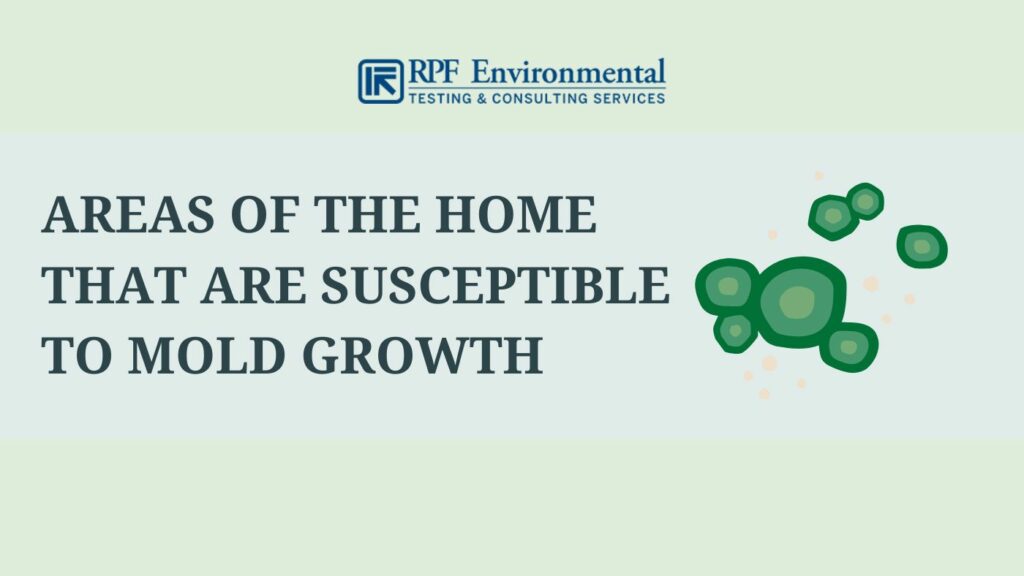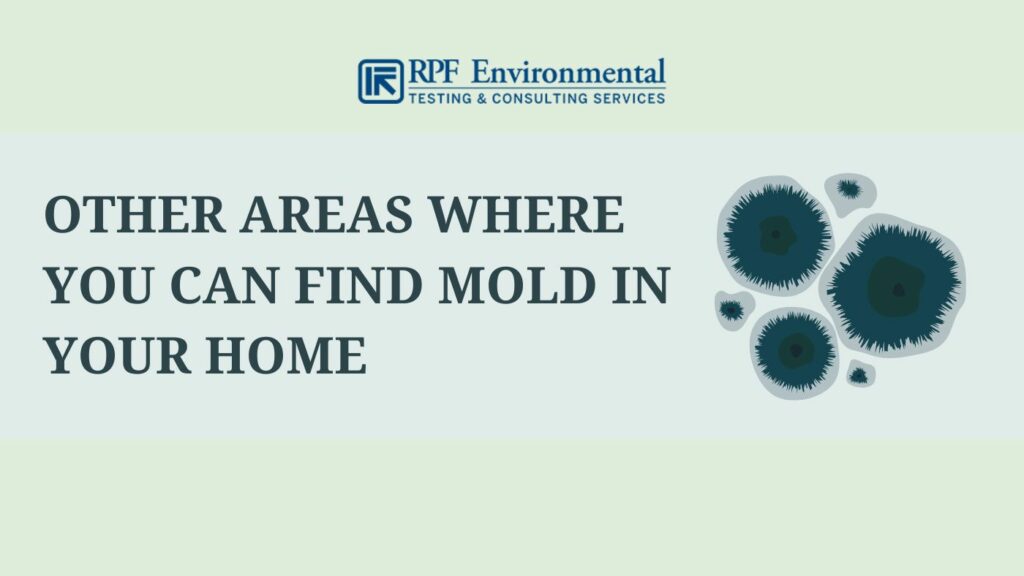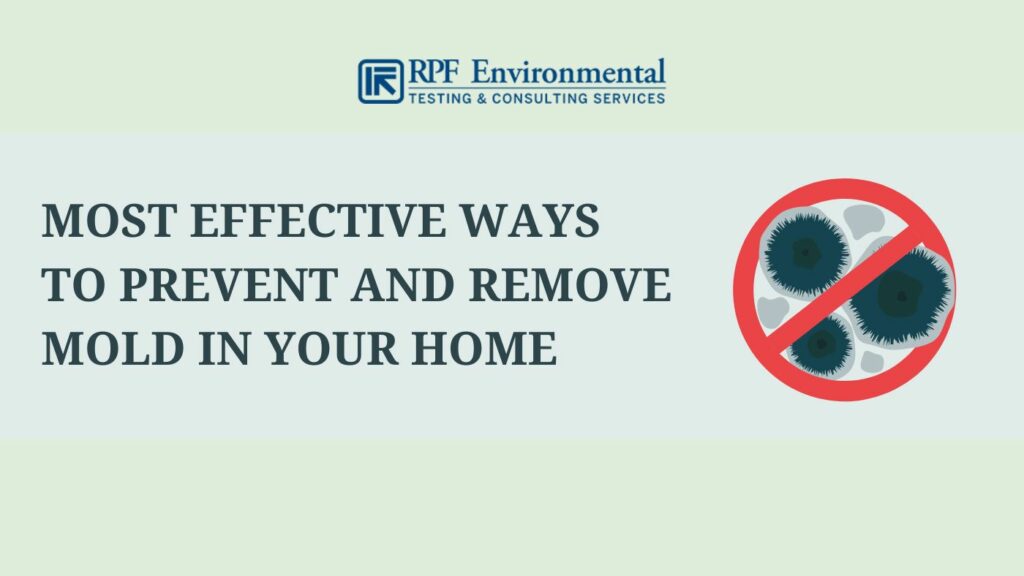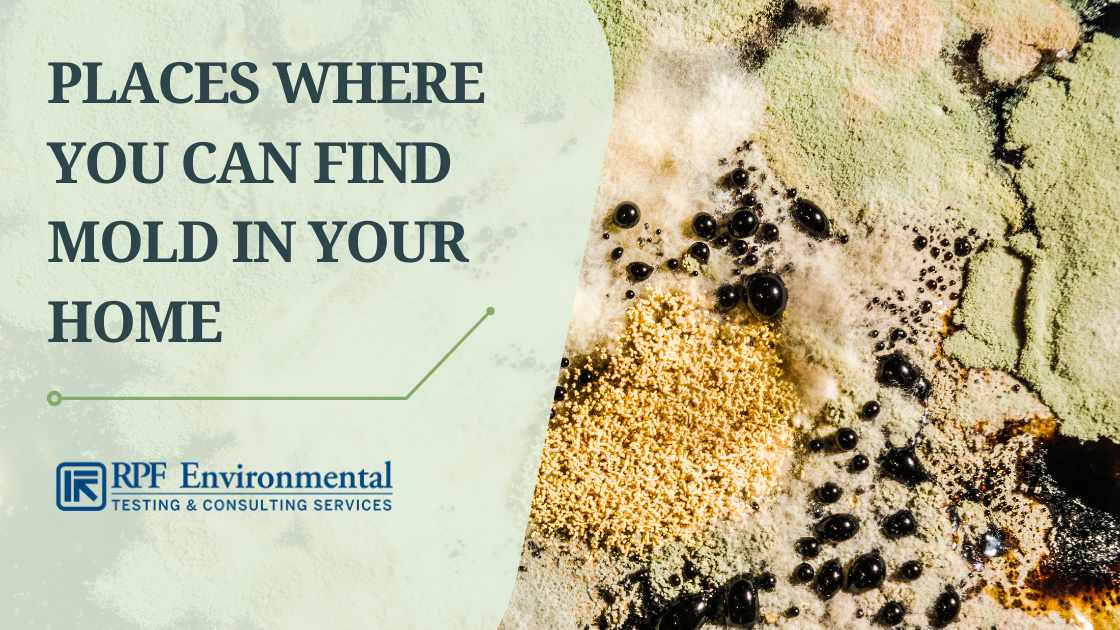Do you have damp, musty areas in your home? Is there a strange odor that you can’t seem to get rid of? If so, you may be dealing with a mold problem. In this blog, we’ll discuss the specific places where mold can be found in the home and why mold infestations start in the first place.
We’ll also provide practical solutions that any homeowner can use to prevent, get rid of, and keep mold from coming back. Read on to learn more about how to keep your home safe and healthy!

RPF Environmental offers mold testing and indoor air quality testing services for various industries in New Hampshire, Massachusetts, Maine, and other areas across the country. Contact us now!
How Does Mold Enter Your Home and Grow?
According to CDC’s basic facts about mold and dampness, mold can enter your home through the following:
- Airborne mold attached to your pets, shoes, and clothing that are carried indoors
- HVAC systems
- Vents
- Windows
- Open doorways
What Are the Common Sources of Moisture That Lead to Mold Growth?
CDC also mentioned mold spores will grow when they come into contact with:
- Flooded areas that are not dried quickly
- Surfaces with excessive moisture like leaking plant pots, walls, pipes, and roofs
Drainage problems, improper appliance ventilation, humidifiers, condensation, and steam are other moisture sources that cause mold to grow. Also, there are many materials in your home that provide nutrients for mold to grow such as cellulose materials (e.g. paper products, wood products, and cardboard).
Other materials that support mold infestation are:
- Dust
- Paint
- Insulation materials
- Wallpaper
- Upholstery
- Fabric
- Carpet
- Drywall
Areas of the Home That Are Susceptible to Mold Growth

To make it easier for you, we’ve listed the specific areas where you might find mold, what causes mold to grow in these areas, and how to prevent mold infestations below.
1. Kitchen Mold
| Why Mold Grows | Where You Might Find Mold | How You Can Prevent Mold Growth |
|---|---|---|
| – Increased humidity due to washing dishes, cooking, or appliances (e.g. dishwasher) – Leaking pipes/appliances – Floods – Spills – Poor ventilation – Leftovers in your pantry and fridge – Food crumbs that weren’t cleaned – Bad weatherproofing | – Underneath your sink – Pantry – Backsplashes – Windows – Kitchen cabinets Other areas where mold can grow: – Piled up dishes in your sink – Wet sponges – Caddies – Fridge water dispensers, drip pans, and vegetable drawer – Dishwasher, blender, stove, microwave, coffee makers – Trash cans – Wooden cutting boards – Rubber spatulas | – Dispose of old food – Wipe down surfaces regularly – Clean your appliances from grease splatters and food spills – Open windows and use a fan when doing dishes and cooking – Avoid piling up your dishes – Clean your fridge often |
2. Bathroom Mold
| Why Mold Grows | Where You Might Find Mold | How You Can Prevent Mold Growth |
|---|---|---|
| – High humidity created by moisture and heat when using the bathroom – Leaky pipes, toilets, and sinks – Lack of ventilation – Missing caulking – Damp materials | – Tile grout – Ceiling – Bathtub – Showers – Walls – Sinks (on and underneath) – Wall behind your toilet and under the toilet tank – Wood – Wallpaper – Doors – Exhaust fans – Storage spaces Other areas where mold can grow: – Showerhead – Faucets – Shower curtains – Rugs – Carpets – Washcloths – Loofahs – Toiletry holders – Shampoo bottles | – Use a dehumidifier, air conditioner, and a ventilation fan – Keep bathroom surfaces clean and dry – Fix leaky pipes and faucets – Clean rugs and curtains with sanitizing products – Keep shower curtains stretched to their full lengths – Hang damp rugs and towels in well-ventilated areas – Use high-gloss paint to reduce moisture absorption |
3. Bedroom Mold
| Why Mold Grows | Where You Might Find Mold | How You Can Prevent Mold Growth |
| – Condensation on windows – High humidity levels – Leaking roof and pipes | – Wallpapers – Drywalls – Around windows – Heating and air conditioning vents Other areas where mold can grow: – Mattresses – Carpets – Furniture | – Invest in mold-resistant mattresses – Wipe down your walls regularly – Use an A/C or dehumidifier – Open your windows and doors for a few minutes a day – Vacuum your carpets regularly – Move your furniture away from your walls |
Other Areas Where You Can Find Mold in Your Home

In addition to the three main areas we’ve mentioned, below are specific surfaces around your home (living rooms, home offices, laundry rooms, etc.) where mold can grow:
- Basement: Poor ventilation, broken pipes, and seepage cause mold growth. Among the best ways to prevent mold here is by using a dehumidifier.
- Attics: Attic mold spores can get into ventilation systems and cause mold to spread throughout your home. Make sure to repair roofing issues and insulate your home properly.
- Crawl Spaces: You can use dehumidifiers that are designed for crawl spaces. Also, ensure that you seal them completely from outdoor moisture.
- Laundry Rooms: Sinks and washing machines create moisture in addition to wet clothes contributing to this moisture.
- Garage: Puddles created by water dripping from your car as well as leaks can cause mold growth.
- Indoor Plants: Don’t overwater them.
- Seals, Drip Pans, and Coils on Appliances: Clean them regularly.
- AC Units: Make sure they are dry to the touch.
- Dehumidifiers: They can cause mold infestations when not properly maintained and cleaned.
- Filing Cabinets: Damp paper files in your cabinets encourage mold growth and are hard to remove. Prevention is the only key.
- Toys: Your kids might have been putting the toys in their mouths which accumulates moisture. Better clean them regularly.
- Floor Mats: Mold can grow under them so make sure to rinse them often.
- Water Heaters and Boilers: Clogged drains can cause mold to grow around them and on your walls and floors. Make sure to inspect and clean them often.
- Chimneys and Fireplaces: They are cold and damp when not in use and the porous bricks can spread mold quickly.
What Should You Do if You Found Mold in Your Home and When Should You Seek Professional Remediation?
You can’t rely on routine sampling to determine the health risks associated with the mold in your home because its effect will vary greatly. But regardless of the type of mold you found, you should remove it immediately to avoid potential health risks and prevent the colony from growing further. However, experts recommend contacting a professional mold testing removal company for the remediation of big colonies (more than 10 square feet).
Most Effective Ways to Prevent and Remove Mold in Your Home

Here are mold prevention tips from CDC’s basic facts about mold and dampness and EPA’s brief guide to mold in your home which provides a summary of the ones we’ve mentioned above:
- Fix mold-causing conditions (e.g. flooding, infiltration, and water leaks)
- Reduce humidity levels by using dehumidifiers/air conditioners, venting appliances properly, and using exhaust fans when cooking and running appliances
- Ensure proper ventilation in your kitchen and bathroom
- Prevent condensation by covering cold surfaces and increasing air temperature
As for mold cleanup, you can scrub them off from hard surfaces using water and detergent. For porous materials like carpet and ceiling tiles, you might need to throw them away. You can read more in EPA’s mold cleanup in your home article and in our DIY mold remediation and cleaning mold with bleach blogs.
FAQs
Mold colonies grow on any damp surface and reproduce by spores. These spores float in the air and start a mold colony once they fall onto surfaces that can provide them with the suitable nutrients to survive. These include organic and cellulose-based materials like wooden surfaces, food, plants, and carpets.
Inhalation of mold spores and ingestion of contaminated food are the main methods on how people get exposed to mold. Even touching them can cause allergic reactions that include skin rash, sneezing, runny nose, and red eyes. You can find more about mold and your health here.
We have mentioned a lot of places where you can find mold in your home here. But, the most unexpected places where they can hide are window sills, refrigerator drip pans, wallpapers, air conditioners, dishes, window seals, washing machines, chimneys, and carpets. Learn more on our hidden mold in the house blog.
Some mold allergy symptoms you should watch out for are asthma flare-ups, migraine, skin rash, hives, frequent sneezing, watery or itchy eyes and nose, dry cough, nasal stuffiness, shortness of breath, fever, and chills.
Conclusion
To summarize our discussion, mold is often caused by poor ventilation, leaking plumbing, bad weatherproofing, flooding, and leaving surfaces and fabrics wet. The general solution you can do is to reduce moisture and humidity in the area to prevent respiratory problems caused by mold allergy. You can clean small mold infestations yourself, but always consult a professional for larger colonies.
Let RPF Environmental help you plan out effective mold remediation solutions with our professional mold testing services to keep your family safe! We serve homeowners, businesses, and government institutions nationwide including New Hampshire, Massachusetts, Maine, and others. Reach out to us now!




